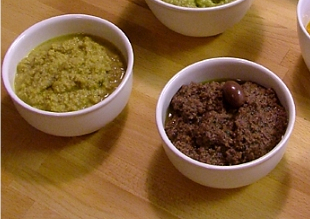Tapenade
Tapenade is a savory paste traditionally made from olives, capers, anchovies, and olive oil. It is a popular appetizer in the Mediterranean cuisine, particularly associated with the Provence region of France. Tapenade is often served as a spread on bread, crackers, or vegetables, and can also be used as a condiment or ingredient in various dishes.
History[edit | edit source]
The origins of tapenade can be traced back to ancient times, with variations of olive-based pastes found in several Mediterranean cultures. The name "tapenade" comes from the Provençal word tapeno, meaning caper. The recipe was formalized in the late 19th century in Marseille, France, by chef Meynier, who combined olives, capers, anchovies, and olive oil into a paste that has since become a staple of Provençal cuisine.
Ingredients[edit | edit source]
The primary ingredients of tapenade are:
- Olives - Typically black olives are used, but variations with green olives also exist.
- Capers - Small, pickled flower buds that add a distinctive tangy flavor.
- Anchovies - Salt-cured fish that provide a salty, umami depth to the paste.
- Olive oil - Used to bind the ingredients together into a spreadable paste.
Additional ingredients may include garlic, lemon juice, herbs such as thyme or rosemary, and pepper.
Preparation[edit | edit source]
To prepare tapenade, the olives, capers, and anchovies are finely chopped or blended together. Olive oil is then gradually mixed in until the desired consistency is achieved. The paste can be made to be chunky or smooth, depending on personal preference. Garlic, lemon juice, and herbs can be added for extra flavor.
Serving Suggestions[edit | edit source]
Tapenade can be served in a variety of ways:
- As a spread on toasted baguette slices, crackers, or crostini.
- As a dip for raw or blanched vegetables.
- As a filling or topping for fish, chicken, or vegetables.
- Mixed into pasta or used as a condiment for sandwiches.
Variations[edit | edit source]
While the traditional tapenade is made with black olives, capers, anchovies, and olive oil, there are numerous variations that include:
- Green olive tapenade, which uses green olives for a slightly different flavor profile.
- Artichoke tapenade, which includes artichoke hearts for a milder taste.
- Sun-dried tomato tapenade, which incorporates sun-dried tomatoes for a sweet and tangy flavor.
Cultural Significance[edit | edit source]
Tapenade is more than just a food item in the Mediterranean; it represents the rich culinary traditions of the region. It is a common feature in Provence and throughout the Mediterranean, where olives and olive oil play a central role in the diet.
Navigation: Wellness - Encyclopedia - Health topics - Disease Index - Drugs - World Directory - Gray's Anatomy - Keto diet - Recipes
Search WikiMD
Ad.Tired of being Overweight? Try W8MD's physician weight loss program.
Semaglutide (Ozempic / Wegovy and Tirzepatide (Mounjaro) available.
Advertise on WikiMD
WikiMD is not a substitute for professional medical advice. See full disclaimer.
Credits:Most images are courtesy of Wikimedia commons, and templates Wikipedia, licensed under CC BY SA or similar.Contributors: Prab R. Tumpati, MD

